The Golden Dawn or Thoth Method
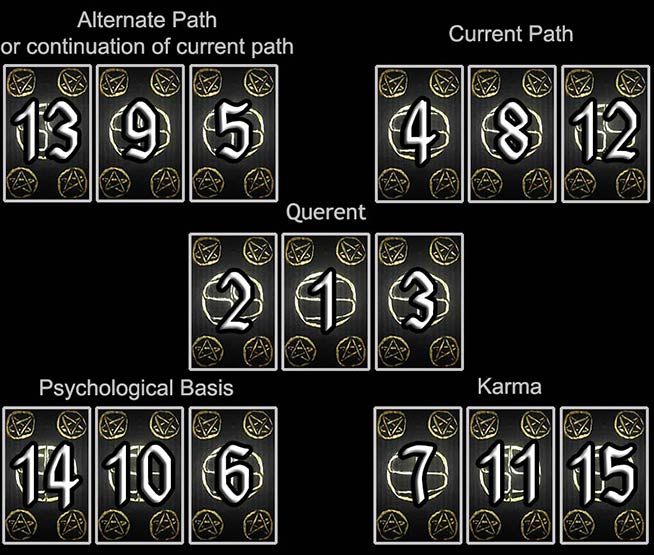
Difficulty: Complicated
Note: Tarot decks that use reversed cards such as the Rider-Waite do not work well with this spread, which was designed to be read using elemental dignity.
The Golden Dawn spread is best suited for use with the bifrost Tarot and especially the Book of Thoth, as these decks are meant to be read a certain way with the court cards. Princes and queens represent actual men and women connected with the matter, while princesses generally represent ideas; thoughts or opinions, and knights represent arrival or departure of a matter depending on the direction faced.
In this tarot spread, particular attention should be paid to a card's exact position in relation to its neighbours. Whether the neighbour cards bear the same energy (suit) determines whether a card is considered well-dignified or ill-dignified. Opposite suits ill-dignify each other, while other suits are considered friendly. Tarot cards of the same suit or element strengthen each other.
As with other tarot spreads, it is important to count the cards' tendencies, such as whether there is a lot of one particular suit or number pattern. The patterns reveal special messages. Having several majors present indicates higher forces at work, several cups suggest strong emotions, etc.
Card #1 represents the reader and the nature of the topic at hand.
Cards #2 & #3 are read in extension of #1 to further comprehend the nature of the topic.
The two sets of three tarot cards at the top of the spread represent chronological sets of events. The current path as it would unfold naturally is represented by cards #4, #8, & #12. The alternate path that could be taken is represented by cards #13, #9, & #5. However, if the reader gets the feeling these cards are telling them they go together, then the alternate path is to be considered an extension of the current path, and to be read chronologically in this order: #4, #8, #12, #13, #9, #5. Just keep in mind: this is only if the two paths seem particularly similar.
Cards #14, #10, & #6 shed light upon the psychological undertones of the current issue.
Cards #7, #11, & #15 represent the influences of karma and destiny beyond the reader's control. These cards suggest adapting to this, as fate.
Your Golden Dawn Reading
| The Alternate Path (or Extension of Current Path) |
Your Current Path |
|||||
IV. The Emperor |
X. The Wheel of Fortune |
XI. Justice |
VI. The Lovers |
VII. The Chariot |
III. The Empress |
|
| The Querent | ||||||
XVII. The Star |
XX. Judgement |
XIX. The Sun |
||||
| The Psychological Basis | Karma | |||||
XXI. The World |
XIII. Death |
VIII. Strength |
XIV. Temperance |
IX. The Hermit |
XII. The Hanged Man |
|
The Querent
cards represent the querent and the nature of the topic at hand. The first card (in the center of the spread) represents the very core of the matter, and the other two cards around it are added to it in order to further comprehend the nature of the topic.
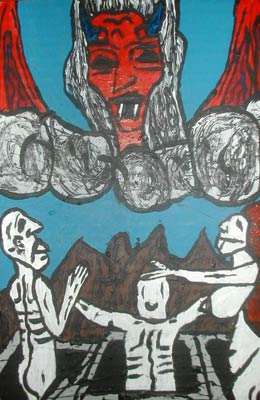
Symbolism:
Judgment depicts a haunting scene of the dead rising from crypts bathed in an eerie, silvery glow. A vampire angel hovers above, blowing a trumpet, its sound visible as luminous, curling waves. The figures below lift their arms skyward, drawn by the call to awakening. A massive, ancient tree stands in the background, its roots tangled with bones, symbolizing the cyclical nature of life and death.
Meaning:
Judgment signifies renewal, self-assessment, and a call to rise above the past. It asks you to confront your actions, choices, and truths, encouraging accountability and forgiveness. This card often appears during moments of profound transition, marking the opportunity to shed old burdens and embrace a higher purpose.
Keywords:
Upright: Awakening, renewal, self-assessment, reckoning, forgiveness, rebirth, transformation.
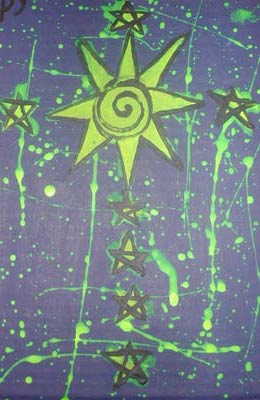
Reversed
Symbolism:
The Star depicts a luminous vampire bathing in a moonlit pool, her pale skin shimmering with starlight. She pours blood from a goblet into the water, symbolizing renewal and the cycle of life. Above her, a constellation forms the shape of a chalice, representing hope and inspiration. The night sky is clear, and the surrounding landscape, though desolate, begins to show signs of new growth.
Meaning:
The Star embodies hope, inspiration, and spiritual renewal. It encourages you to trust in the universe and your own inner light, even during challenging times. This card often appears after a period of struggle, signaling healing, clarity, and the promise of brighter days ahead.
Reversed, the Star warns of doubt, pessimism, or a loss of direction. It may suggest the need to reconnect with your dreams or rekindle your faith in the future.
Keywords:
Reversed: Doubt, despair, loss of faith, disconnection, hopelessness, lack of direction.
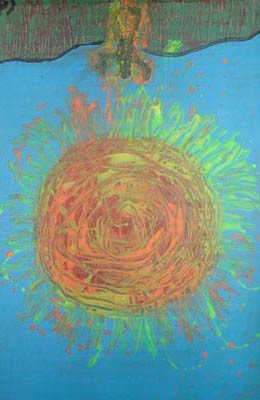
Reversed
Symbolism:
The Sun features a radiant figure standing atop a stone altar, their outstretched arms ablaze with golden light. Behind them, a massive blood-red sun dominates the sky, casting warm, revitalizing rays over a once-shadowed landscape. Sunflowers bloom vibrantly in the foreground, representing vitality and joy. A golden wolf stands beside the figure, symbolizing loyalty and enlightenment.
Meaning:
The Sun represents joy, success, and clarity. It heralds a period of positivity, growth, and accomplishment, reminding you to embrace life with enthusiasm and gratitude. This card suggests that challenges are behind you, and a brighter path lies ahead.
Reversed, the Sun may indicate temporary setbacks, self-doubt, or overconfidence. It suggests the need to find balance and reconnect with your inner light.
Keywords:
Reversed: Setbacks, doubt, overconfidence, lack of clarity, diminished enthusiasm.
Your Current Path
cards represent your current path as it would unfold naturally. These cards are read in chronological order from left to right.
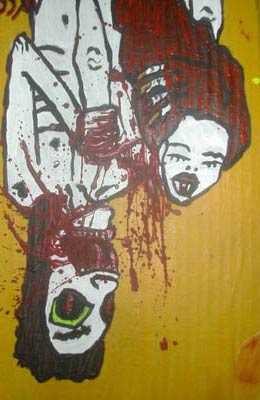
Reversed
Symbolism:
The Lovers stand under a blood-red moon, their forms entwined yet distinct. One figure appears human, while the other is clearly vampiric, emphasizing the tension between attraction and duality. Between them, a single rose blooms, its petals tinged with crimson—a symbol of both love and sacrifice. In the background, a shadowy figure looms, hinting at the influence of external forces or choices yet to be made.
Meaning:
The Lovers symbolize connection, union, and the choices that shape our relationships and paths. This card often appears during moments of deep emotional connection or when a major decision requires alignment with your values and desires. It reminds you to consider the balance of give and take in relationships, whether romantic, platonic, or spiritual.
Reversed, this card warns of disharmony, imbalance, or misaligned priorities in relationships. It may also suggest indecision or a failure to honor your personal values.
Keywords:
Reversed: Disharmony, imbalance, misalignment, indecision, temptation, conflict.
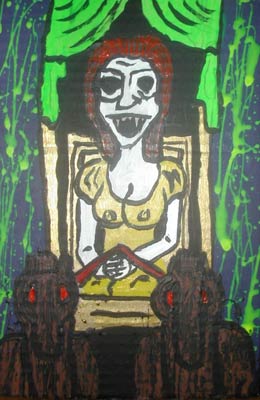
Symbolism:
The Chariot is a sinister yet majestic vehicle drawn by two spectral horses, one black and one white, representing opposing forces. A Nosferatu figure stands at its helm, cloaked in shadows, holding a whip of shadowy tendrils. The chariot races through a mist-laden nightscape, its wheels crushing fallen leaves and brittle bones, symbolizing the journey's sacrifices and challenges.
Meaning:
The Chariot signifies determination, control, and the will to overcome obstacles. It calls for focused effort and harnessing conflicting energies to achieve a goal. This card often appears when decisive action and self-discipline are needed to navigate a complex situation. It encourages you to take charge of your direction and steer with purpose.
Keywords:
Upright: Determination, control, focus, discipline, willpower, triumph, direction.

Symbolism:
The Empress sits upon her throne, her presence commanding yet nurturing. She holds the Hand of Glory, a macabre artifact symbolizing her power to claim whatever she desires. Her surroundings are lush and fertile, with dark roses blooming amidst the decay—symbols of beauty and abundance arising from even the grimmest conditions. Her expression is one of calm authority, radiating life-giving energy.
Meaning:
The Empress represents creation, fertility, and the nurturing aspects of life. She signifies abundance and the ability to bring ideas, projects, or relationships to fruition. This card invites you to connect with your creative or maternal instincts and embrace the cycles of growth and renewal. It may also point to emotional or physical abundance and a celebration of life's pleasures.
Keywords:
Upright: Fertility, abundance, creation, nurturing, beauty, growth, motherhood, diplomacy.
The Alternate Path
cards represent the alternate path that you could choose to take in lieu of the Current Path. However, if the cards that come up seem to indicate that they go along with the Current Path, these three cards should be interpretted not as an Alternate Path, but as a chronological extension of the Current Path (also read from left to right).
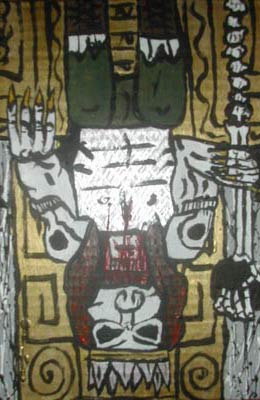
Reversed
Symbolism:
The Emperor is a Nosferatu seated on a blood-soaked throne, gripping the Hand of Glory as his scepter of authority. His crimson cloak flows like a river of lifeblood, symbolizing his dominion over life and death. Behind him, a craggy fortress rises, representing stability and the structures of power. His stern, commanding gaze reinforces his role as a protector and enforcer of order.
Meaning:
The Emperor symbolizes authority, stability, and protection. He represents the need for structure and discipline to achieve goals and maintain order. As a figure of leadership, he encourages reason and conviction in decision-making. This card often indicates a time to take control of your environment or to rely on a strong, supportive figure for guidance.
Reversed, the Emperor warns of rigidity, tyranny, or a loss of control. It may signify struggles with authority, immaturity, or the misuse of power.
Keywords:
Reversed: Tyranny, rigidity, immaturity, chaos, rebellion, over-control.
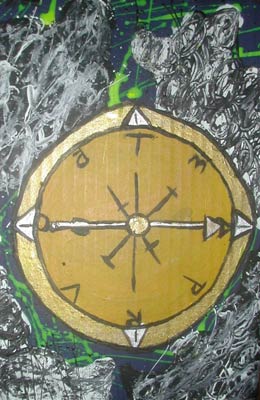
Symbolism:
The Wheel of Fortune appears as a rotating wheel carved from black obsidian, inscribed with arcane runes glowing faintly in red and gold. Around the wheel, shadowy figures—some triumphant, others despairing—are caught in its orbit, symbolizing the cyclical nature of fate. At its center, a single, unblinking eye peers outward, embodying the watchful presence of destiny and the unpredictable forces that govern life.
Meaning:
The Wheel of Fortune represents cycles, change, and the influence of fate. It reminds you that life is constantly shifting between highs and lows, and adaptability is key to navigating these changes. When this card appears, it often signals a turning point, a shift in fortune, or the hand of destiny at work. It encourages you to seize opportunities while being mindful of the bigger picture.
Keywords:
Upright: Change, destiny, cycles, luck, turning point, opportunities, adaptability.
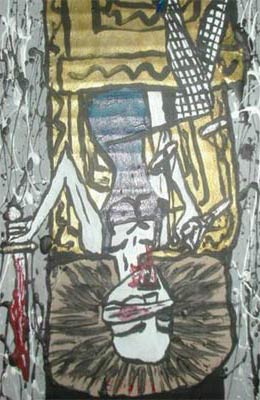
Reversed
Symbolism:
Justice is depicted as a pale, vampiric figure holding a pair of scales in one hand and a blood-stained sword in the other. One side of the scale holds a black feather, while the other holds a human heart, symbolizing the balance between moral accountability and emotional truth. Her blindfold is sheer, hinting at impartiality tempered with insight. Behind her, a blood-red curtain reveals fragmented mirrors reflecting distorted truths.
Meaning:
Justice embodies fairness, truth, and accountability. She calls for honesty and objectivity in your actions and decisions, ensuring that you consider all perspectives before rendering judgment. This card often signals the need to weigh your choices carefully and to take responsibility for the consequences of past actions.
Reversed, Justice suggests imbalance, dishonesty, or unfair treatment. It may indicate a refusal to acknowledge the truth or an avoidance of accountability for your actions.
Keywords:
Reversed: Dishonesty, unfairness, imbalance, corruption, denial of truth, avoidance.
The Psychological Basis
cards shed light upon the psychological undertones of the current problem.
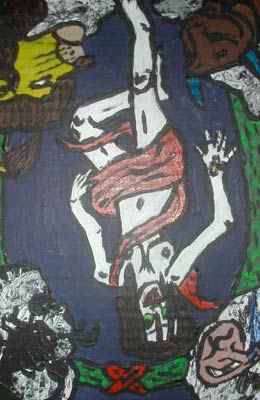
Reversed
Symbolism:
The World depicts a powerful figure standing within a glowing circle of blood-red roses, symbolizing completion and unity. The four corners of the card feature elemental creatures: a bat, a wolf, a raven, and a serpent, representing balance and harmony among all forces. A starry night sky stretches infinitely behind the figure, while they hold a silver orb and a golden key, symbolizing mastery and fulfillment.
Meaning:
The World represents completion, fulfillment, and the achievement of long-term goals. It signifies harmony, wholeness, and the realization of your place in the greater tapestry of existence. This card often marks the end of a significant journey, celebrating your success and inviting you to share your gifts with others.
Reversed, the World suggests delays, unfinished business, or feelings of incompleteness. It may indicate the need to tie up loose ends before moving forward.
Keywords:
Reversed: Delays, lack of closure, incompletion, stagnation, unfinished business, imbalance.
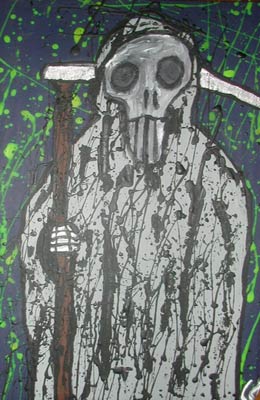
Symbolism:
Death is depicted as a cloaked, skeletal figure riding a dark horse with glowing red eyes. In one hand, it wields a scythe, its blade glinting in the moonlight, while the other hand scatters withered petals onto the barren ground. The landscape around them is bleak, with twisted trees and ruins, but in the distance, the faint glow of dawn promises renewal. At the figure's feet, flowers begin to bloom amid the decay.
Meaning:
Death symbolizes transformation, endings, and the promise of new beginnings. It encourages you to release what no longer serves you, making way for growth and renewal. This card often marks a significant transition or the closure of a chapter in life, reminding you that every ending carries the seed of a new beginning.
Keywords:
Upright: Transformation, endings, renewal, release, change, rebirth, closure.
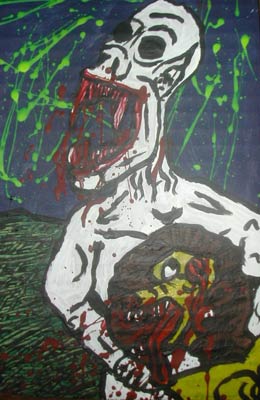
Symbolism:
Strength is portrayed as a vampiric figure gently taming a feral wolf under the light of a crescent moon. The figure's touch is both commanding and tender, symbolizing the balance of power and compassion. The wolf, once a creature of wild aggression, now gazes at its tamer with loyalty and calm. Around them, thorny vines twist, a reminder of the challenges inherent in mastering one's inner beasts.
Meaning:
Strength embodies courage, inner power, and the triumph of compassion over brute force. It urges you to face challenges with patience and resilience, relying on your inner calm to overcome fear and adversity. This card often signals the need to master emotions, demonstrating that true strength lies in self-control and grace.
Keywords:
Upright: Inner strength, courage, resilience, patience, self-control, compassion, calm.
Karma
These cards represent the influences of karma and destiny that are beyond your control. They suggest adapting to this fate.
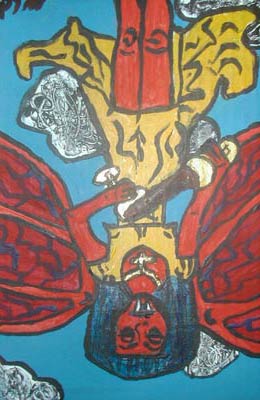
Reversed
Symbolism:
Temperance is represented by a vampiric figure gracefully pouring a stream of crimson liquid from one chalice into another, symbolizing balance and harmony. She stands with one foot in a dark pool and the other on solid ground, representing the interplay between emotion and reason. Her wings are half-feathered, half-batlike, indicating the union of opposing forces. The background shifts between twilight and dawn, underscoring equilibrium.
Meaning:
Temperance embodies balance, moderation, and the harmonious blending of opposites. It encourages patience and the careful integration of different aspects of your life. This card often suggests the need for self-restraint, collaboration, or finding common ground in a situation.
Reversed, Temperance warns of excess, discord, or impatience. It may indicate a lack of balance or difficulty reconciling conflicting priorities or emotions.
Keywords:
Reversed: Excess, imbalance, discord, impatience, extremes, lack of focus.
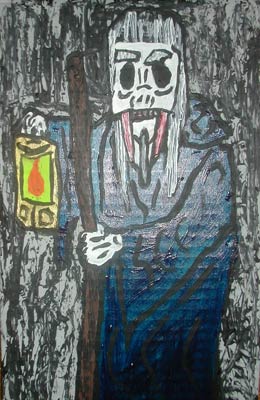
Symbolism:
The Hermit is depicted as an ancient vampire cloaked in tattered robes, holding a lantern that emits an eerie, bluish glow. He stands atop a desolate mountain peak, surrounded by swirling mist. The lantern's light reveals faint traces of hidden paths, while his posture suggests quiet contemplation. The darkness around him symbolizes isolation, while the light represents the wisdom gained through introspection.
Meaning:
The Hermit signifies solitude, introspection, and the search for deeper truths. He encourages stepping back from external distractions to seek clarity and wisdom within. This card often appears when you need time alone to reflect on your journey or make decisions based on your inner guidance. It may also indicate the guidance of a mentor or wise figure.
Keywords:
Upright: Introspection, solitude, wisdom, self-reflection, spiritual journey, guidance.
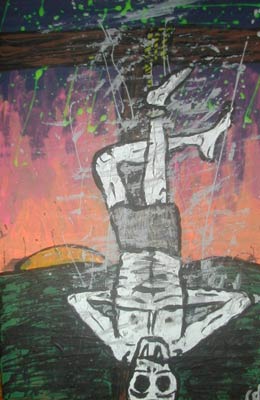
Symbolism:
The Hanged Man is shown suspended upside-down from a barren tree, his foot bound by a chain of silver. His expression is serene, as if willingly surrendering to his predicament. A pool of crimson liquid forms beneath him, reflecting a full moon, symbolizing surrender and the potential for transformation. Surrounding him, shadows twist into shapes of wings, hinting at the freedom that comes through letting go.
Meaning:
The Hanged Man represents surrender, perspective, and the need to pause. It encourages you to let go of control and view a situation from a different angle. This card often signals a period of waiting or self-sacrifice, where stepping back can lead to greater understanding or personal growth.
Keywords:
Upright: Surrender, perspective, pause, letting go, reflection, patience, transformation.
